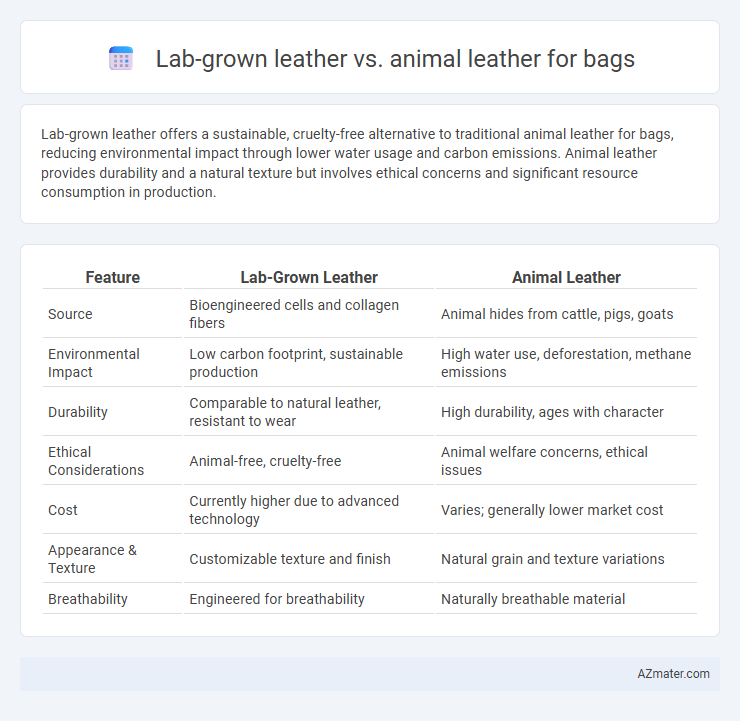Lab-grown leather offers a sustainable, cruelty-free alternative to traditional animal leather for bags, reducing environmental impact through lower water usage and carbon emissions. Animal leather provides durability and a natural texture but involves ethical concerns and significant resource consumption in production.
Table of Comparison
| Feature | Lab-Grown Leather | Animal Leather |
|---|---|---|
| Source | Bioengineered cells and collagen fibers | Animal hides from cattle, pigs, goats |
| Environmental Impact | Low carbon footprint, sustainable production | High water use, deforestation, methane emissions |
| Durability | Comparable to natural leather, resistant to wear | High durability, ages with character |
| Ethical Considerations | Animal-free, cruelty-free | Animal welfare concerns, ethical issues |
| Cost | Currently higher due to advanced technology | Varies; generally lower market cost |
| Appearance & Texture | Customizable texture and finish | Natural grain and texture variations |
| Breathability | Engineered for breathability | Naturally breathable material |
Introduction to Lab-Grown Leather and Animal Leather
Lab-grown leather, created through bio-fabrication techniques using cultured animal cells, offers an innovative and sustainable alternative to traditional animal leather produced from cowhide and other animal skins. Unlike conventional leather that involves resource-intensive livestock farming and tanning processes, lab-grown leather reduces environmental impact by minimizing water use, greenhouse gas emissions, and harmful chemical treatments. Both materials provide similar durability and aesthetic qualities for bags, but lab-grown leather aims to meet growing consumer demand for eco-friendly and cruelty-free fashion accessories.
Production Processes: Lab-Grown vs Animal Leather
Lab-grown leather is produced using cultured animal cells cultivated in controlled environments, reducing the need for livestock and minimizing environmental impact. In contrast, animal leather production involves raising and slaughtering animals, tanning, and chemical treatments that contribute to greenhouse gas emissions and water pollution. Lab-grown leather offers a more sustainable alternative by eliminating traditional farming and intensive resource use associated with animal leather manufacturing.
Material Properties: Texture, Durability, and Flexibility
Lab-grown leather offers a consistent texture that mimics the natural grain of animal leather while eliminating irregularities, making it ideal for high-quality bag production. It exhibits enhanced durability due to engineered fibers that resist wear, scratches, and water damage better than traditional animal leather. Flexibility in lab-grown leather can be precisely controlled during manufacturing, allowing for customizable softness and pliability that supports ergonomic bag designs without compromising strength.
Environmental Impact Comparison
Lab-grown leather significantly reduces environmental impact by minimizing deforestation, water consumption, and greenhouse gas emissions compared to traditional animal leather production. Animal leather involves high methane emissions from livestock, extensive land use, and toxic chemical treatments that contribute to soil and water pollution. Sustainable alternatives like lab-grown leather offer a lower carbon footprint and reduced resource depletion, aligning with eco-friendly fashion industry goals.
Ethical Considerations
Lab-grown leather offers a sustainable and cruelty-free alternative to traditional animal leather by eliminating the need for animal slaughter, significantly reducing the ethical concerns tied to animal welfare. The production of lab-grown leather minimizes environmental impact through lower greenhouse gas emissions and reduced land use compared to conventional leather farming, aligning with ethical consumption trends. Consumers prioritizing animal rights and ecological preservation increasingly prefer lab-grown leather for bags, reflecting a shift towards more responsible and humane fashion choices.
Cost and Scalability
Lab-grown leather offers a cost-effective alternative to traditional animal leather by reducing expenses linked to livestock maintenance and resource-intensive processing. Scalable production of lab-grown leather leverages biotechnological advancements, enabling consistent output without the limitations of animal rearing cycles or environmental variability. In contrast, animal leather production faces scalability challenges due to breeding timelines, land use, and fluctuating raw material availability, often leading to higher costs and supply inconsistencies for bag manufacturing.
Design Versatility and Customization
Lab-grown leather offers superior design versatility and customization options for bags, allowing precise control over texture, color, and pattern that are difficult to achieve with traditional animal leather. Advanced manufacturing techniques enable intricate detailing and consistent quality, supporting innovative and personalized bag designs. In contrast, animal leather's natural variations limit uniform customization and require more manual labor for specific finishes and styles.
Consumer Perceptions and Trends
Lab-grown leather is increasingly favored by environmentally-conscious consumers seeking sustainable and cruelty-free alternatives to traditional animal leather for bags. Market research indicates a growing trend toward lab-grown leather due to its reduced ecological footprint and similar aesthetic qualities compared to animal leather. Consumer perceptions highlight lab-grown leather as a modern, ethical choice, while animal leather maintains appeal for its heritage, durability, and luxury status.
Market Availability and Leading Brands
Lab-grown leather, increasingly adopted by innovative brands like Vegea and Modern Meadow, offers sustainable alternatives with growing market availability in premium and eco-conscious bag collections. Animal leather remains dominant, favored by established luxury labels such as Gucci, Louis Vuitton, and Hermes, supported by extensive supply chains and consistent market demand. The shift toward lab-grown leather is accelerating due to consumer demand for ethical materials, yet traditional animal leather maintains strong market presence and brand loyalty worldwide.
Future Prospects for Bag Manufacturing
Lab-grown leather offers sustainable alternatives with lower environmental impact, reducing reliance on animal farming and deforestation in bag manufacturing. Innovations in biofabrication enable scalable production of durable, high-quality leather that mimics traditional animal leather's texture and strength, appealing to eco-conscious consumers. As technology advances, lab-grown leather is expected to revolutionize the bag industry by providing ethical, cost-effective, and customizable materials for future fashion trends.

Infographic: Lab-grown leather vs Animal leather for Bag
 azmater.com
azmater.com